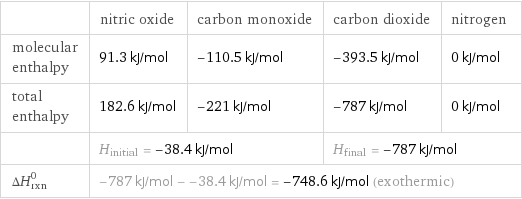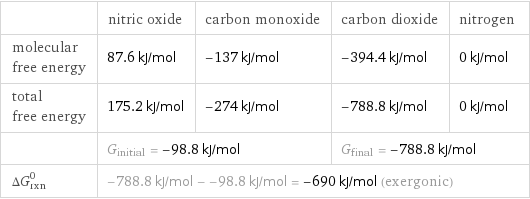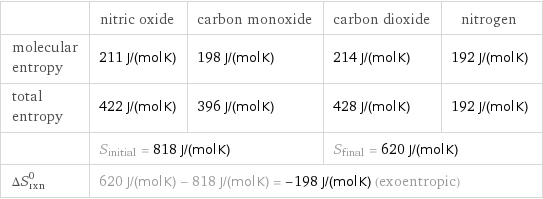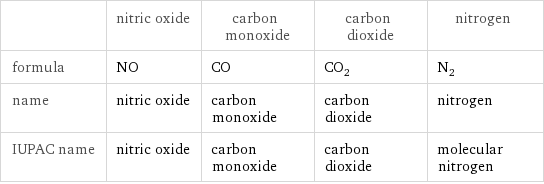Input interpretation

NO (nitric oxide) + CO (carbon monoxide) ⟶ CO_2 (carbon dioxide) + N_2 (nitrogen)
Balanced equation

Balance the chemical equation algebraically: NO + CO ⟶ CO_2 + N_2 Add stoichiometric coefficients, c_i, to the reactants and products: c_1 NO + c_2 CO ⟶ c_3 CO_2 + c_4 N_2 Set the number of atoms in the reactants equal to the number of atoms in the products for N, O and C: N: | c_1 = 2 c_4 O: | c_1 + c_2 = 2 c_3 C: | c_2 = c_3 Since the coefficients are relative quantities and underdetermined, choose a coefficient to set arbitrarily. To keep the coefficients small, the arbitrary value is ordinarily one. For instance, set c_4 = 1 and solve the system of equations for the remaining coefficients: c_1 = 2 c_2 = 2 c_3 = 2 c_4 = 1 Substitute the coefficients into the chemical reaction to obtain the balanced equation: Answer: | | 2 NO + 2 CO ⟶ 2 CO_2 + N_2
Structures

+ ⟶ +
Names

nitric oxide + carbon monoxide ⟶ carbon dioxide + nitrogen
Reaction thermodynamics
Enthalpy

| nitric oxide | carbon monoxide | carbon dioxide | nitrogen molecular enthalpy | 91.3 kJ/mol | -110.5 kJ/mol | -393.5 kJ/mol | 0 kJ/mol total enthalpy | 182.6 kJ/mol | -221 kJ/mol | -787 kJ/mol | 0 kJ/mol | H_initial = -38.4 kJ/mol | | H_final = -787 kJ/mol | ΔH_rxn^0 | -787 kJ/mol - -38.4 kJ/mol = -748.6 kJ/mol (exothermic) | | |
Gibbs free energy

| nitric oxide | carbon monoxide | carbon dioxide | nitrogen molecular free energy | 87.6 kJ/mol | -137 kJ/mol | -394.4 kJ/mol | 0 kJ/mol total free energy | 175.2 kJ/mol | -274 kJ/mol | -788.8 kJ/mol | 0 kJ/mol | G_initial = -98.8 kJ/mol | | G_final = -788.8 kJ/mol | ΔG_rxn^0 | -788.8 kJ/mol - -98.8 kJ/mol = -690 kJ/mol (exergonic) | | |
Entropy

| nitric oxide | carbon monoxide | carbon dioxide | nitrogen molecular entropy | 211 J/(mol K) | 198 J/(mol K) | 214 J/(mol K) | 192 J/(mol K) total entropy | 422 J/(mol K) | 396 J/(mol K) | 428 J/(mol K) | 192 J/(mol K) | S_initial = 818 J/(mol K) | | S_final = 620 J/(mol K) | ΔS_rxn^0 | 620 J/(mol K) - 818 J/(mol K) = -198 J/(mol K) (exoentropic) | | |
Equilibrium constant
![Construct the equilibrium constant, K, expression for: NO + CO ⟶ CO_2 + N_2 Plan: • Balance the chemical equation. • Determine the stoichiometric numbers. • Assemble the activity expression for each chemical species. • Use the activity expressions to build the equilibrium constant expression. Write the balanced chemical equation: 2 NO + 2 CO ⟶ 2 CO_2 + N_2 Assign stoichiometric numbers, ν_i, using the stoichiometric coefficients, c_i, from the balanced chemical equation in the following manner: ν_i = -c_i for reactants and ν_i = c_i for products: chemical species | c_i | ν_i NO | 2 | -2 CO | 2 | -2 CO_2 | 2 | 2 N_2 | 1 | 1 Assemble the activity expressions accounting for the state of matter and ν_i: chemical species | c_i | ν_i | activity expression NO | 2 | -2 | ([NO])^(-2) CO | 2 | -2 | ([CO])^(-2) CO_2 | 2 | 2 | ([CO2])^2 N_2 | 1 | 1 | [N2] The equilibrium constant symbol in the concentration basis is: K_c Mulitply the activity expressions to arrive at the K_c expression: Answer: | | K_c = ([NO])^(-2) ([CO])^(-2) ([CO2])^2 [N2] = (([CO2])^2 [N2])/(([NO])^2 ([CO])^2)](../image_source/6064e09e647bfad3cf722db6b0e23437.png)
Construct the equilibrium constant, K, expression for: NO + CO ⟶ CO_2 + N_2 Plan: • Balance the chemical equation. • Determine the stoichiometric numbers. • Assemble the activity expression for each chemical species. • Use the activity expressions to build the equilibrium constant expression. Write the balanced chemical equation: 2 NO + 2 CO ⟶ 2 CO_2 + N_2 Assign stoichiometric numbers, ν_i, using the stoichiometric coefficients, c_i, from the balanced chemical equation in the following manner: ν_i = -c_i for reactants and ν_i = c_i for products: chemical species | c_i | ν_i NO | 2 | -2 CO | 2 | -2 CO_2 | 2 | 2 N_2 | 1 | 1 Assemble the activity expressions accounting for the state of matter and ν_i: chemical species | c_i | ν_i | activity expression NO | 2 | -2 | ([NO])^(-2) CO | 2 | -2 | ([CO])^(-2) CO_2 | 2 | 2 | ([CO2])^2 N_2 | 1 | 1 | [N2] The equilibrium constant symbol in the concentration basis is: K_c Mulitply the activity expressions to arrive at the K_c expression: Answer: | | K_c = ([NO])^(-2) ([CO])^(-2) ([CO2])^2 [N2] = (([CO2])^2 [N2])/(([NO])^2 ([CO])^2)
Rate of reaction
![Construct the rate of reaction expression for: NO + CO ⟶ CO_2 + N_2 Plan: • Balance the chemical equation. • Determine the stoichiometric numbers. • Assemble the rate term for each chemical species. • Write the rate of reaction expression. Write the balanced chemical equation: 2 NO + 2 CO ⟶ 2 CO_2 + N_2 Assign stoichiometric numbers, ν_i, using the stoichiometric coefficients, c_i, from the balanced chemical equation in the following manner: ν_i = -c_i for reactants and ν_i = c_i for products: chemical species | c_i | ν_i NO | 2 | -2 CO | 2 | -2 CO_2 | 2 | 2 N_2 | 1 | 1 The rate term for each chemical species, B_i, is 1/ν_i(Δ[B_i])/(Δt) where [B_i] is the amount concentration and t is time: chemical species | c_i | ν_i | rate term NO | 2 | -2 | -1/2 (Δ[NO])/(Δt) CO | 2 | -2 | -1/2 (Δ[CO])/(Δt) CO_2 | 2 | 2 | 1/2 (Δ[CO2])/(Δt) N_2 | 1 | 1 | (Δ[N2])/(Δt) (for infinitesimal rate of change, replace Δ with d) Set the rate terms equal to each other to arrive at the rate expression: Answer: | | rate = -1/2 (Δ[NO])/(Δt) = -1/2 (Δ[CO])/(Δt) = 1/2 (Δ[CO2])/(Δt) = (Δ[N2])/(Δt) (assuming constant volume and no accumulation of intermediates or side products)](../image_source/09b8b98afdc23f238163a8b3085c77ca.png)
Construct the rate of reaction expression for: NO + CO ⟶ CO_2 + N_2 Plan: • Balance the chemical equation. • Determine the stoichiometric numbers. • Assemble the rate term for each chemical species. • Write the rate of reaction expression. Write the balanced chemical equation: 2 NO + 2 CO ⟶ 2 CO_2 + N_2 Assign stoichiometric numbers, ν_i, using the stoichiometric coefficients, c_i, from the balanced chemical equation in the following manner: ν_i = -c_i for reactants and ν_i = c_i for products: chemical species | c_i | ν_i NO | 2 | -2 CO | 2 | -2 CO_2 | 2 | 2 N_2 | 1 | 1 The rate term for each chemical species, B_i, is 1/ν_i(Δ[B_i])/(Δt) where [B_i] is the amount concentration and t is time: chemical species | c_i | ν_i | rate term NO | 2 | -2 | -1/2 (Δ[NO])/(Δt) CO | 2 | -2 | -1/2 (Δ[CO])/(Δt) CO_2 | 2 | 2 | 1/2 (Δ[CO2])/(Δt) N_2 | 1 | 1 | (Δ[N2])/(Δt) (for infinitesimal rate of change, replace Δ with d) Set the rate terms equal to each other to arrive at the rate expression: Answer: | | rate = -1/2 (Δ[NO])/(Δt) = -1/2 (Δ[CO])/(Δt) = 1/2 (Δ[CO2])/(Δt) = (Δ[N2])/(Δt) (assuming constant volume and no accumulation of intermediates or side products)
Chemical names and formulas

| nitric oxide | carbon monoxide | carbon dioxide | nitrogen formula | NO | CO | CO_2 | N_2 name | nitric oxide | carbon monoxide | carbon dioxide | nitrogen IUPAC name | nitric oxide | carbon monoxide | carbon dioxide | molecular nitrogen